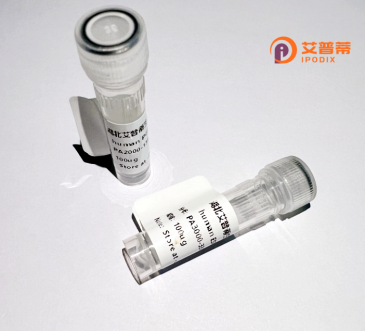
| 纯度 | >90%SDS-PAGE. |
| 种属 | Human |
| 靶点 | VPS53 |
| Uniprot No | Q5VIR6 |
| 内毒素 | < 0.01EU/μg |
| 表达宿主 | E.coli |
| 表达区间 | 1-699 aa |
| 活性数据 | MMEEEELEFV EELEAVLQLT PEVQLAIEQV FPSQDPLDRA DFNAVEYINT LFPTEQSLAN IDEVVNKIRL KIRRLDDNIR TVVRGQTNVG QDGRQALEEA QKAIQQLFGK IKDIKDKAEK SEQMVKEITR DIKQLDHAKR HLTTSITTLN HLHMLAGGVD SLEAMTRRRQ YGEVANLLQG VMNVLEHFHK YMGIPQIRQL SERVKAAQTE LGQQILADFE EAFPSQGTKR PGGPSNVLRD ACLVANILDP RIKQEIIKKF IKQHLSEYLV LFQENQDVAW LDKIDRRYAW IKRQLVDYEE KYGRMFPREW CMAERIAVEF CHVTRAELAK IMRTRAKEIE VKLLLFAIQR TTNFEGFLAK RFSGCTLTDG TLKKLESPPP STNPFLEDEP TPEMEELATE KGDLDQPKKP KAPDNPFHGI VSKCFEPHLY VYIESQDKNL GELIDRFVAD FKAQGPPKPN TDEGGAVLPS CADLFVYYKK CMVQCSQLST GEPMIALTTI FQKYLREYAW KILSGNLPKT TTSSGGLTIS SLLKEKEGSE VAKFTLEELC LICNILSTAE YCLATTQQLE EKLKEKVDVS LIERINLTGE MDTFSTVISS SIQLLVQDLD AACDPALTAM SKMQWQNVEH VGDQSPYVTS VILHIKQNVP IIRDNLASTR KYFTQFCVKF ANSFIPKFIT HLFKCKPISM VGAEQVRWT |
| 分子量 | 94.4 kDa |
| 蛋白标签 | His tag N-Terminus |
| 缓冲液 | PBS, pH7.4, containing 0.01% SKL, 1mM DTT, 5% Trehalose and Proclin300. |
| 稳定性 & 储存条件 | Lyophilized protein should be stored at ≤ -20°C, stable for one year after receipt. Reconstituted protein solution can be stored at 2-8°C for 2-7 days. Aliquots of reconstituted samples are stable at ≤ -20°C for 3 months. |
| 复溶 | Always centrifuge tubes before opening.Do not mix by vortex or pipetting. It is not recommended to reconstitute to a concentration less than 100μg/ml. Dissolve the lyophilized protein in distilled water. Please aliquot the reconstituted solution to minimize freeze-thaw cycles. |
1. **"VPS53 mutations cause progressive cerebello-cerebral atrophy and neurodegeneration"**
- 作者:Feinstein et al.
- 摘要:研究发现VPS53基因突变导致重组人VPS53蛋白功能缺陷,引发细胞内囊泡运输异常,进而引起小脑萎缩和神经退行性疾病。研究通过患者样本和细胞模型证实了VPS53在维持神经元存活中的关键作用。
2. **"Structural insights into the human GARP complex assembly by VPS53"**
- 作者:Liang et al.
- 摘要:通过冷冻电镜解析了重组人VPS53蛋白与GARP复合体其他亚基(VPS50、VPS51、VPS52)的三维结构,揭示了VPS53在介导复合体组装及溶酶体逆向运输中的分子机制。
3. **"Functional characterization of recombinant human VPS53 in retrograde transport pathways"**
- 作者:Park et al.
- 摘要:利用CRISPR敲除细胞系和重组表达技术,证明VPS53蛋白是GARP复合体的核心组分,调控高尔基体到内体的逆向运输,其缺失导致溶酶体酶分选异常及细胞内脂质积累。
4. **"VPS53 deficiency disrupts hepatic lipid metabolism via impaired lysosomal function"**
- 作者:Zhang et al.
- 摘要:在肝脏特异性敲除VPS53的小鼠模型中,重组人VPS53的缺失导致溶酶体功能损伤,引发胆固醇代谢紊乱和非酒精性脂肪肝病(NAFLD)表型,提示其作为代谢疾病治疗靶点的潜力。
VPS53 is a critical component of the EARP (endosome-associated recycling protein) complex, which plays a key role in regulating endosomal membrane trafficking and cargo recycling in eukaryotic cells. As a member of the VPS (vacuolar protein sorting) family, it is involved in retrograde transport pathways that retrieve proteins and lipids from endosomes to the trans-Golgi network (TGN). This process is essential for maintaining cellular homeostasis, lysosome function, and receptor signaling.
The human VPS53 gene encodes a 1.049-amino-acid protein that interacts with other EARP subunits (VPS50. VPS51. VPS52) to mediate tethering of recycled vesicles to target membranes. Dysregulation of VPS53 is linked to neurological disorders, including a rare autosomal recessive condition characterized by developmental delay, ataxia, and cerebellar atrophy. Studies in model organisms highlight its role in neuronal survival, suggesting functional conservation across species.
Recombinant human VPS53 protein is typically produced via heterologous expression systems (e.g., mammalian, insect cells) for functional studies. It enables researchers to dissect molecular mechanisms of endosomal trafficking, model disease-associated mutations, and explore therapeutic strategies. Its structural analysis (e.g., cryo-EM) has provided insights into EARP complex assembly and interaction networks. Current research focuses on linking VPS53 dysfunction to broader pathophysiological contexts, including neurodegeneration and lysosomal storage disorders.
×